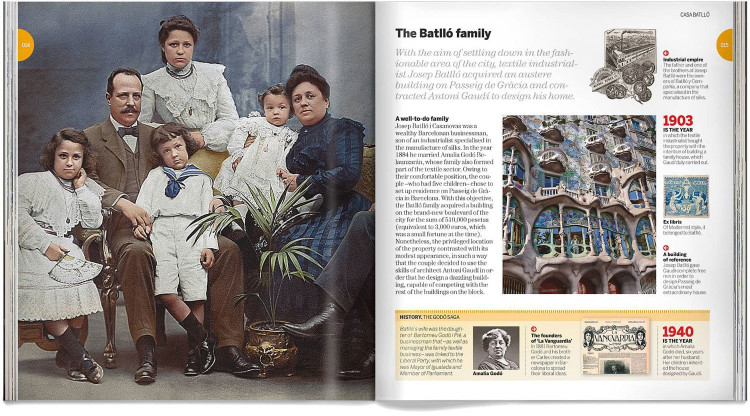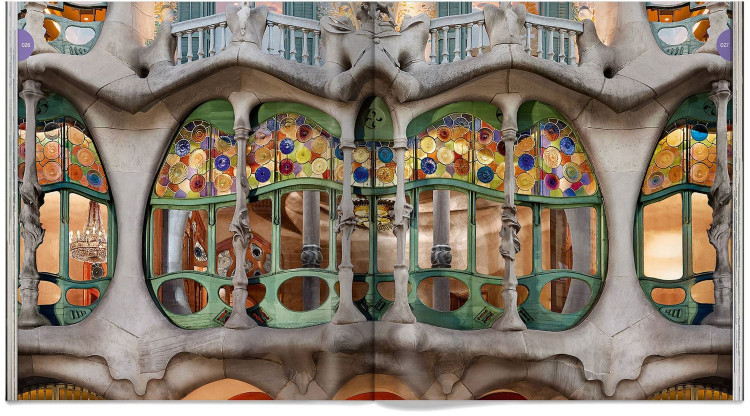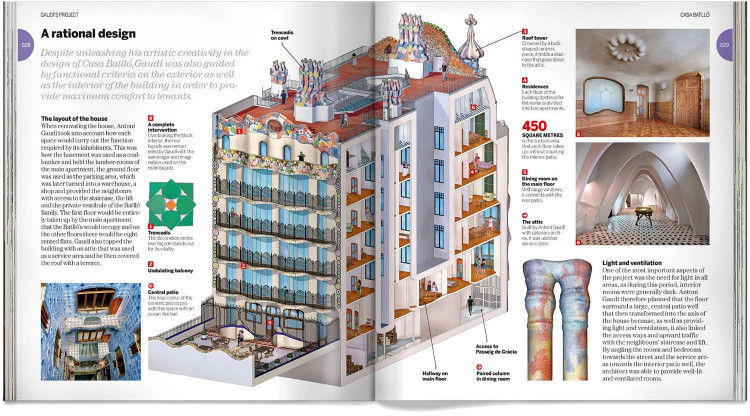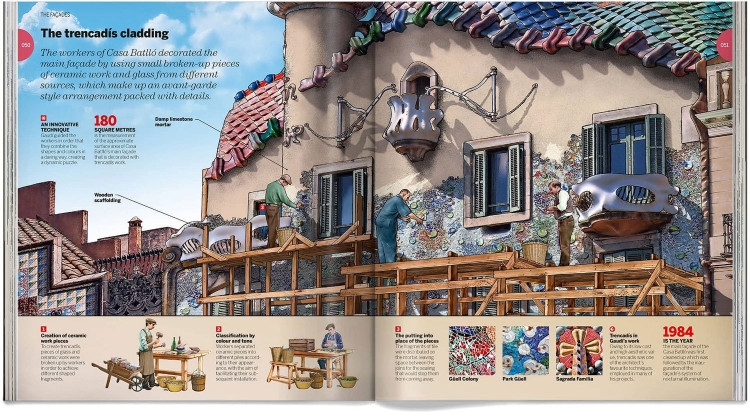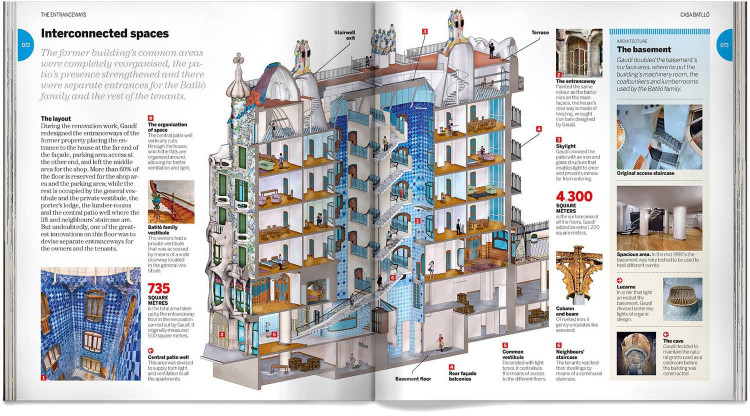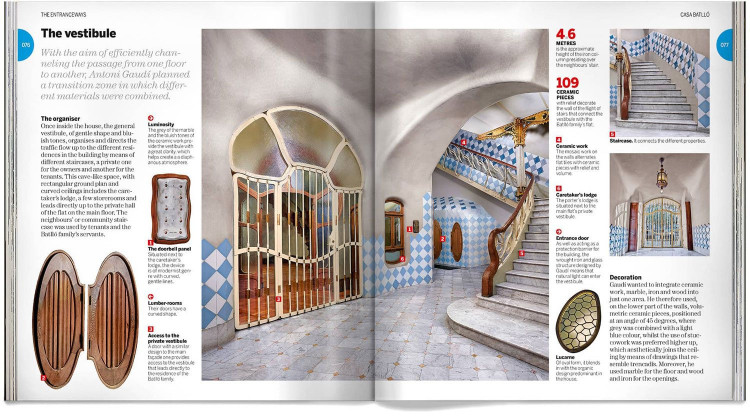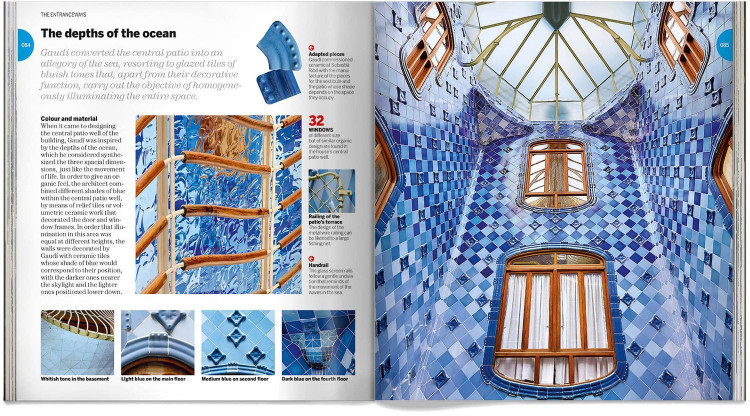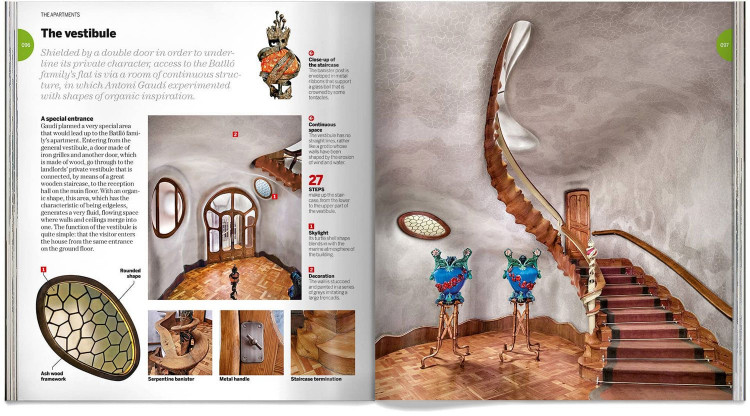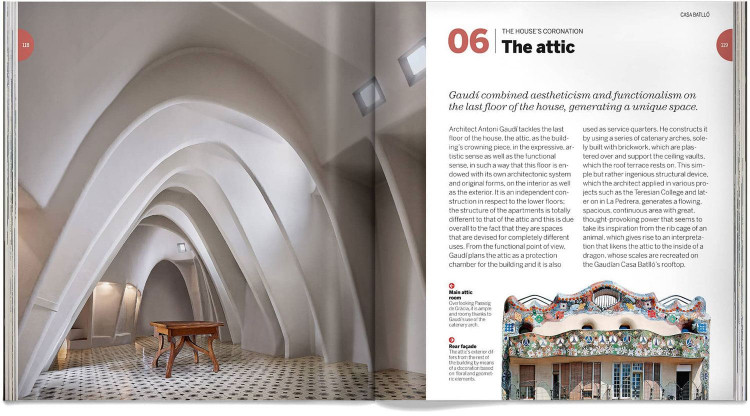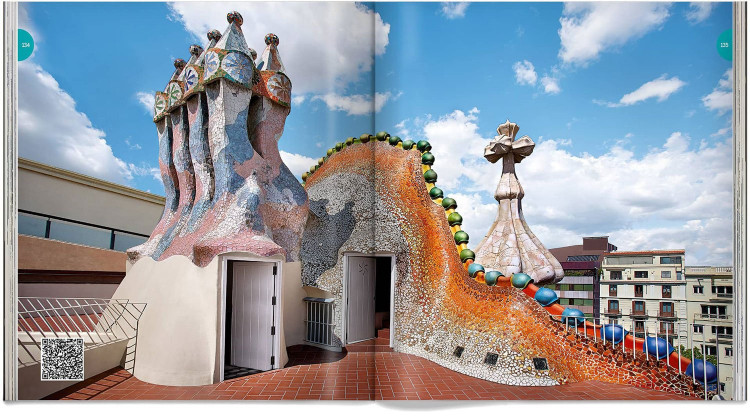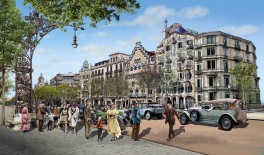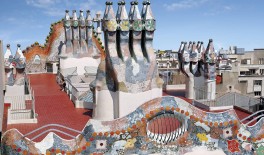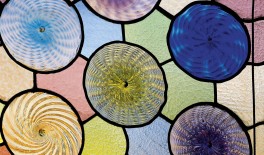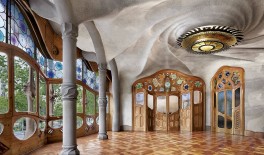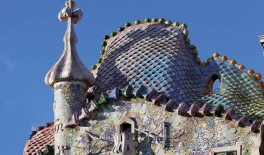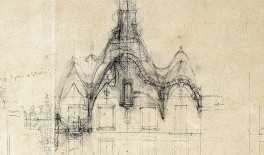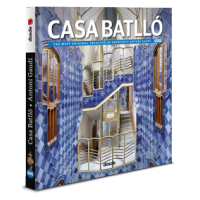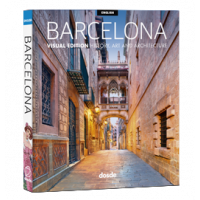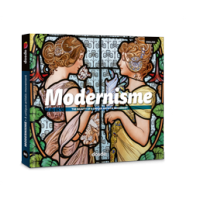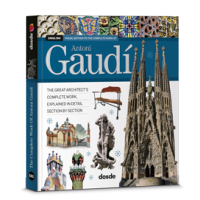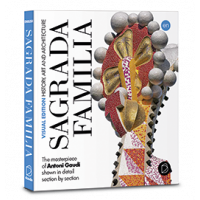Casa Batlló
A building transformed into a work of art
RETURN
About the book Casa Batlló
Casa Batlló is the best example of the overwhelming creativity that Gaudí drew on when devising his projects. What was originally going to be a complete refurbishment of an apartment building located at number 43 on Passeig de Gràcia ended up converting into a masterpiece of universal architecture, as well as one of Barcelona's emblems.
This book dedicated to Casa Batlló of Barcelona published by Dosde explains all the details that occurred during the project and Gaudí's influences at the moment of its creation, analysing each corner of this work of modernist architecture, full of fantasy, in which Gaudí managed to carry out a defense of happiness, creating one his most avant-garde and thought-provoking buildings.
This book is a comprehensive guided tour around every corner of the building. Its explanatory texts deal with the history of Casa Batlló in an entertaining and concise manner, while at the same time they delve into the architectonic and symbolic importance of this unique building in the world, declared a World Heritage Site by Unesco.
The book includes exclusive, detailed 3D illustrations to show off the inside of Gaudí's building, as well as drawings, infographs and more than 300 high quality pictures. Therefore, the reader can obtain a comprehensive view of the work and appreciate Gaudí's creative energy when devising his works.
This book dedicated to Casa Batlló of Barcelona published by Dosde explains all the details that occurred during the project and Gaudí's influences at the moment of its creation, analysing each corner of this work of modernist architecture, full of fantasy, in which Gaudí managed to carry out a defense of happiness, creating one his most avant-garde and thought-provoking buildings.
This book is a comprehensive guided tour around every corner of the building. Its explanatory texts deal with the history of Casa Batlló in an entertaining and concise manner, while at the same time they delve into the architectonic and symbolic importance of this unique building in the world, declared a World Heritage Site by Unesco.
The book includes exclusive, detailed 3D illustrations to show off the inside of Gaudí's building, as well as drawings, infographs and more than 300 high quality pictures. Therefore, the reader can obtain a comprehensive view of the work and appreciate Gaudí's creative energy when devising his works.
Visual Edition
Casa Batlló
It includes exclusive content
Made with environmentally friendly paper
Official licensed product
Multilanguage: Available in 8 languages
About the book Casa Batlló
Casa Batlló is the best example of the overwhelming creativity that Gaudí drew on when devising his projects. What was originally going to be a complete refurbishment of an apartment building located at number 43 on Passeig de Gràcia ended up converting into a masterpiece of universal architecture, as well as one of Barcelona's emblems.
This book dedicated to Casa Batlló of Barcelona published by Dosde explains all the details that occurred during the project and Gaudí's influences at the moment of its creation, analysing each corner of this work of modernist architecture, full of fantasy, in which Gaudí managed to carry out a defense of happiness, creating one his most avant-garde and thought-provoking buildings.
This book is a comprehensive guided tour around every corner of the building. Its explanatory texts deal with the history of Casa Batlló in an entertaining and concise manner, while at the same time they delve into the architectonic and symbolic importance of this unique building in the world, declared a World Heritage Site by Unesco.
The book includes exclusive, detailed 3D illustrations to show off the inside of Gaudí's building, as well as drawings, infographs and more than 300 high quality pictures. Therefore, the reader can obtain a comprehensive view of the work and appreciate Gaudí's creative energy when devising his works.
This book dedicated to Casa Batlló of Barcelona published by Dosde explains all the details that occurred during the project and Gaudí's influences at the moment of its creation, analysing each corner of this work of modernist architecture, full of fantasy, in which Gaudí managed to carry out a defense of happiness, creating one his most avant-garde and thought-provoking buildings.
This book is a comprehensive guided tour around every corner of the building. Its explanatory texts deal with the history of Casa Batlló in an entertaining and concise manner, while at the same time they delve into the architectonic and symbolic importance of this unique building in the world, declared a World Heritage Site by Unesco.
The book includes exclusive, detailed 3D illustrations to show off the inside of Gaudí's building, as well as drawings, infographs and more than 300 high quality pictures. Therefore, the reader can obtain a comprehensive view of the work and appreciate Gaudí's creative energy when devising his works.
Videos Casa Batlló
Readers opinions
(5)
RETURN
Reviews
(5)
I liked the extra information on the internet that was offered in the book La Sagrada Familia. Your books provide me with the correct memory of my holiday impressions
The cover caught my eye and on opening it I liked the content.
Excellent books, very complete with photos as well as information.
The book to me is perfect. Thanks!
I have several books and they are of a high quality. They treat the subjects in depth and have very good photos.
Readers opinions
(5)
I liked the extra information on the internet that was offered in the book La Sagrada Familia. Your books provide me with the correct memory of my holiday impressions
The cover caught my eye and on opening it I liked the content.
Additional Information
- Additional Information
- Subtitle: A building transformed into a work of art
- Weight (g): 470
- Binding: Paperback with flaps
- Size (cm): 17,5 x 19,5
- Author: Dosde
- Pages: 0
- Edition: Visual Edition
Casa Batlló and Barcelona
Antoni Gaudí’s creative force can be appreciated in each one of his works, but it is especially apparent in Casa Batlló where he draws on all his imagination and ingenuity. It was in 1904 when the industrialist Josep Batlló commissioned Gaudí with the renovation of a house that he had purchased the year before.
Casa Batlló was constructed between 1904 and 1906 and is, in fact, a radical alteration of a sober Passeig de Gràcia building that was constructed around 1877. Gaudí, having reached artistic maturity and unshackled by academician influences, saw this project as a way of unleashing all his artistic creativity.
Gaudí was by then already a respected architect, but the location of the house, in the Block of Discord, meant he would be sharing space with the best architects of the era. Maybe influenced by this fact or by his innate genius, he designed a house where a feeling of gaiety exuded from each of its corners and where strict constructive functionalism could be blended with his intricate knowledge of the laws of nature.
Although Casa Batlló is admired throughout the entire world, it wasn’t until 2005, ninety-nine years after having been completed, that it was officially recognised as a work of art and declared a World Heritage Site by UNESCO. The complexity of this project by Gaudí has been reflected by means of the publication of numerous books about Casa Batlló.
On the rear façade, Gaudí planned a less drastic intervention but just as effective by means of the construction of undulating terraces and a careful decoration based on the use of trencadís.
On the two façades, Gaudí devised strong contrasts of shapes, colours, textures and finishes. In order to achieve this objective, he turned to a variety of materials such as polished stone, glass, tile work and wrought iron, masterfully combining them to take full advantage of their plasticity and expressivity.
Casa Batlló’s façade is considered by many to be an allegory of the battle between the Patron Saint of Catalonia, Saint George, and a dragon. According to this theory, the roof represents the mythical beast, while the bone-like shapes of the columns and the balconies symbolise his victims. The tower crowned by the four-armed cross would constitute the victorious sword belonging to Saint George, which, was plunged into the dragon’s side, causing the lethal wound from which flowed the blood that stained this area of the roof.
The relationship between Gaudí's work and Saint George is just one of the many Casa Batlló facts.
In his overall conception of the work, the architect did not consider aestheticism to be of more importance than functionalism when putting his ideas into practise. Therefore, the entranceways, the relationship between spaces, illumination and ventilation were treated with the utmost functional meticulousness while at the same time turned into attractive spaces.
The different elements making up the Casa Batlló of Barcelona are a blend of many artisanal skills that include ceramic work, glasswork, wrought iron work and cabinetmaking and they all combine to make the building a clear exponent of modernist art.
Casa Batlló was constructed between 1904 and 1906 and is, in fact, a radical alteration of a sober Passeig de Gràcia building that was constructed around 1877. Gaudí, having reached artistic maturity and unshackled by academician influences, saw this project as a way of unleashing all his artistic creativity.
Gaudí was by then already a respected architect, but the location of the house, in the Block of Discord, meant he would be sharing space with the best architects of the era. Maybe influenced by this fact or by his innate genius, he designed a house where a feeling of gaiety exuded from each of its corners and where strict constructive functionalism could be blended with his intricate knowledge of the laws of nature.
Although Casa Batlló is admired throughout the entire world, it wasn’t until 2005, ninety-nine years after having been completed, that it was officially recognised as a work of art and declared a World Heritage Site by UNESCO. The complexity of this project by Gaudí has been reflected by means of the publication of numerous books about Casa Batlló.
The façades of Casa Batlló
In order to remodel the building, Gaudí chose to modify the compositional lines of its exterior. In this way, the main façade was subject to a complete renovation in which only the position of the windows was maintained. The result was a backdrop divided into three distinct parts: a stone base of organic appearance, a central part decorated with ceramic work and coloured glass, and a roof with tiles similar to a reptile’s scales.On the rear façade, Gaudí planned a less drastic intervention but just as effective by means of the construction of undulating terraces and a careful decoration based on the use of trencadís.
On the two façades, Gaudí devised strong contrasts of shapes, colours, textures and finishes. In order to achieve this objective, he turned to a variety of materials such as polished stone, glass, tile work and wrought iron, masterfully combining them to take full advantage of their plasticity and expressivity.
The Casa Batlló of Barcelona and Saint George
In order to crown the façade of Casa Batlló, Gaudí devised a striking undulating roof that on the Passeig de Gràcia street side was decorated with scale-like tiles carried out in glazed ceramic work in red, blue and green tones. Gaudí finished off the fantastical roof with an equally imaginative cylindrical tower, whose trencadís base is topped by a ceramic, bulbous piece that culminates with a large cross that points to the four points of the compass.Casa Batlló’s façade is considered by many to be an allegory of the battle between the Patron Saint of Catalonia, Saint George, and a dragon. According to this theory, the roof represents the mythical beast, while the bone-like shapes of the columns and the balconies symbolise his victims. The tower crowned by the four-armed cross would constitute the victorious sword belonging to Saint George, which, was plunged into the dragon’s side, causing the lethal wound from which flowed the blood that stained this area of the roof.
The relationship between Gaudí's work and Saint George is just one of the many Casa Batlló facts.
The inside of Casa Batlló
Gaudí devised Casa Batlló as a whole, without distinctions between its inner and outer elements: the interior spaces evolve by means of curved and undulating forms that gently combine with the exterior, with no abrupt differences between the façade and the inside of the building.In his overall conception of the work, the architect did not consider aestheticism to be of more importance than functionalism when putting his ideas into practise. Therefore, the entranceways, the relationship between spaces, illumination and ventilation were treated with the utmost functional meticulousness while at the same time turned into attractive spaces.
The different elements making up the Casa Batlló of Barcelona are a blend of many artisanal skills that include ceramic work, glasswork, wrought iron work and cabinetmaking and they all combine to make the building a clear exponent of modernist art.

